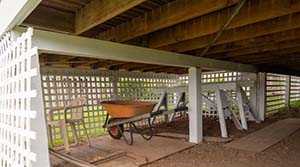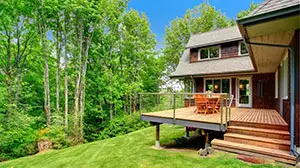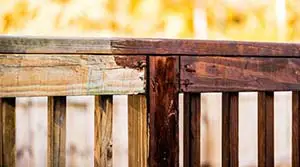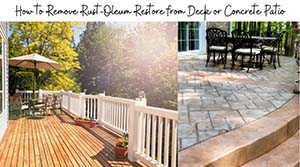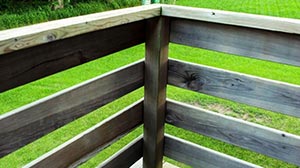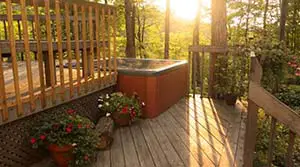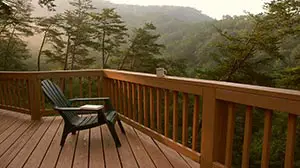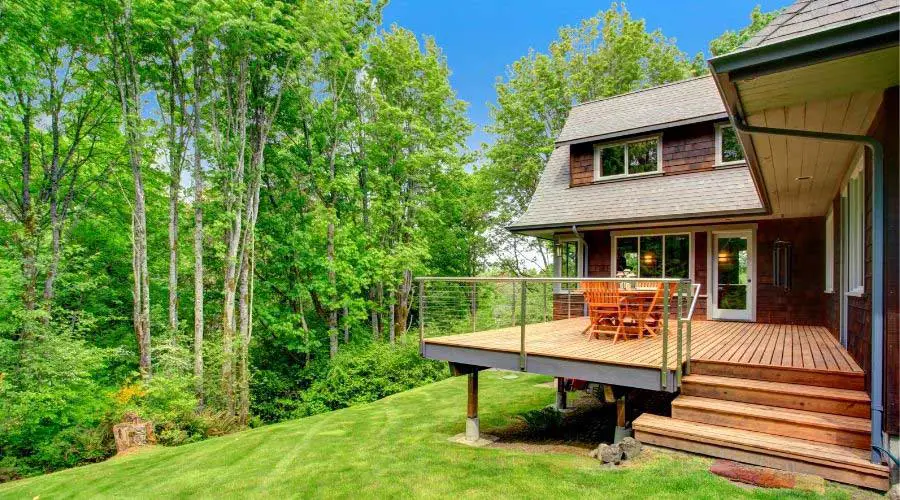
A floating deck is an excellent idea if you enjoy being outside and soaking in the sunshine and fresh air. This type of deck is usually low to the ground and not directly attached to your house. They are a great addition to any backyard or patio area.
Building a floating deck is more complicated than most people think, and you must follow a series of steps and precautions. To create a simple floating deck, you must follow the 11 steps outlined below.
These steps include the following:
- The deck’s height
- Being attached to a house
- Building the deck on the ground
- What to put underneath
- If the deck needs footings
- Putting landscape fabric underneath
- Putting gravel underneath
- Building the deck on a slope
- Building the deck over a septic tank
- Permit requirements
- Taking care of the deck
Below you will find 11 things to know to build a floating deck.
1. How High Can a Floating Deck be?
With very few exceptions, floating decks cannot be higher than 30″ or two and a half feet above the ground.
If you want to build a floating deck more elevated than 30″, then you will have to get a building permit. Anything higher than 30″ will also require the installation of handrails and a stairway.
You can build a floating deck at whatever height you want, but you’ll need a permit to do it. Depending on where you live, the city or building inspector might refuse to grant you a license for what you want to build.
Your floating deck has a maximum height limit, but there isn’t a minimum height for a floating deck. However, depending on how low to the ground it is, it’s no longer considered a floating deck but rather a patio or porch.
2. Can a Floating Deck be Attached to a House?
By definition, you can’t attach a floating deck to a house, and you should keep at least a half-inch gap between them. Your deck can be butting up against the house, but it cannot be physically attached to it with any permanent means.
A floating deck can shift and move with whatever the ground beneath it is doing. As the ground freezes and thaws and washes out after a thunderstorm, it will inevitably cause the deck on top of it to move.
If the deck is nailed or screwed to the house, it could cause damage to the house’s foundation or the deck itself when it moves. For this reason, you should keep at least a half-inch gap between your floating deck and your home.
3. Can You Build a Deck Directly on the Ground?
You can, indeed, build a deck directly on the ground. Floating or freestanding decks can support themselves and be constructed right on the land. However, it’s essential to consider several things when building a deck on the ground.
What is the Composition of the Ground on Which You’re Building?
For a deck to be built directly on the ground, it must remain solid and sturdy. It’s often a good idea to lay a bed of gravel or concrete where your supporting posts or blocks will be. Otherwise, you run the risk of your deck moving or collapsing with too much top-side activity.
What Are You Using to Support the Deck?
You have several options in regards to deck supports. A direct ground build is a fine idea if you use concrete blocks. If you’re using wood or other material prone to water damage, then you may want to go another route.
Is There a Particular City Ordinance that Forbids This?
It’s infrequent for city rules to forbid the construction of decks directly on the ground. However, it’s always a good idea to check and make sure before starting construction.
4. What to Put Under a Floating Deck?
You can put several things under your floating decks, such as sand, mulch, plastic liner, or stone. It would help to prevent weeds, insects, and water from accumulating below your deck.
Water damage is one of the leading causes of deck destruction, and you should take measures to prevent this from happening.
Here are a few of the top materials that get put under a floating deck:
Mulch
Putting mulch under your deck helps prevent water buildup and weeds from growing. The downside of mulch is that insects, reptiles, and other creepy-crawlies love making their homes in mulch.
If you live in a wet climate, mulch also soaks up water and takes a while to dry out. Mold or mildew damage is likely to happen if you build your deck on top of the mulch.
Soil
Soil is the last resort for material below your floating deck. It tends to flood, house insects and other creatures and runs erosion risk. It would help if you explored all other options before opting to leave bare soil below your deck.
Gravel
Gravel is probably your best option in terms of material below a floating deck. I’ll go into more about gravel later, and we’ll discuss why it’s the best option.
Sand
Sand is pretty much as effective as the soil is under a deck. It’s not great at draining water or preventing weed and insect buildup. Just like soil, stay away from the sand if possible.
Plastic
Plastic or other landscape liner is an option that can be used alone or in conjunction with another material under a floating deck. People often use plastic as their base cover and then put sand, soil, or mulch on top.
The pros of plastic are that it will prevent weed and animal buildup. The cons are that it breaks down relatively quickly if left exposed to the elements. Using sand or soil to cover it up will cause the same issues like those listed above.
5. Does a Floating Deck Need Footings?
One of the most significant advantages of a floating deck is that they don’t need footings for support. Footings are the posts that get dug into the ground and support a deck. A footing isn’t required because a floating deck is built directly on the floor or rests on blocks.
While footings aren’t required, you should only use materials that are pressure-treated or waterproof to support your floating deck. Anything less will result in water damage and a compromised deck.
6. Should You Put Landscape Fabric Under a Floating Deck?
Landscape fabric can be beneficial under a floating deck, but it isn’t required. Landscape or other forms of plastic fabric aren’t the most aesthetically pleasing option, and their best use is when combined with gravel or another material.
The benefit of putting landscape fabric under your floating deck will keep weeds and insects from forming homes. It will also prevent erosion and moisture accumulation beneath your deck.
7. Should You Put Gravel Under a Floating Deck?
If you’re going to put Anything under your floating deck, which you should, gravel is the best option available. You can use crushed gravel, pea gravel, or even larger chunks of 2″ gravel as the base layer below your deck. Here are a few of the reasons why gravel is an excellent option.
Improves Rain & Water Drainage
No matter where you live, rain and water will inevitably wind up below your floating deck. Whether it’s from a storm or power washing your deck, water and moisture buildup is a fact of life. Gravel provides the drainage necessary to prevent flooding and pooling under your deck.
Prevents Weeds & Erosion
Gravel is also very effective at preventing weeds from growing under your deck, attracting bugs and other insects. Keeping this from happening is crucial to getting the maximum amount of joy out of your deck.
It’s the Most Pleasing to the Eye
Apart from its practical uses, gravel is also the most aesthetically pleasing thing to put under your deck. Mulch or wood chips are also neat options, but they lack the practical benefits of gravel.
Improves Storage Options
If you plan on storing boxes, bins, and other things under your floating deck, then you’ll want a material that will keep them clean and dry. Gravel is your best option for achieving this goal.
It’s vital that whatever your floating deck is resting on stays dry and out of water. It isn’t as crucial if you use weatherproof wood or cinder blocks to survive in water. However, if you use wood or other material prone to water damage, gravel will be necessary to keep your deck supports out of harm’s way.
8. Can a Floating Deck be Built on a Slope?
You can technically build a floating deck on a slope as long as it’s a very slight one. If the pitch is less than 1″ per foot, making a floating deck on a slope is possible but not practical. If you want your deck to be level, you will need to be strategic with designing the base of your floating deck.
Building a floating deck on a slope will also be costlier due to the extra time and material needed. To have an even surface on your floating deck, you will need to add additional cinder blocks or support beams on the bottom of the slope.
A floating deck on a slope also has the hazard of washing away or slowly moving over time. Rain, snow, the ground freezing and thawing, and several other natural factors can cause the ground beneath your deck to shift. Shifting ground will cause the deck to move right along with it.
9. Can a Floating Deck be Built Over a Septic Tank?
You can build a floating deck over top of a septic tank as long as there is an access door or panel to get to the septic tank. Your septic system needs a cleaning every couple of years, which means that whoever is cleaning it has to be able to get to it.
The same logic applies to gas meters, electric meters, and other eyesores that you may want to hide. As long as people can gain ready access to whatever they need to get to, no rules say that you can’t build on top of septic tanks.
10. Do You Need Permits to Build a Floating Deck?
You don’t need a permit to build a floating deck unless you do one of the following things.
- The square footage exceeds 200 feet: the size of your floating deck is entirely up to you. For some people, 200 square feet isn’t big enough. If that’s the case, you will need to get a building permit for your floating deck.
- You build your deck higher than 30” above the ground: if you want to build a floating deck higher than 2 ½ feet above the grade level of your home, then a building permit will be required almost universally.
- Your floating deck is not attached to your house: you should never directly attach a floating deck to your house, but you can put it right up against it. If you choose to have a floating deck anywhere other than right up against your home, you will need a building permit.
- Your floating deck is not located in front of an egress door: an egress door is direct access between your house and the floating deck. If your deck doesn’t have this feature, then a permit will be required for construction.
Floating deck rules are wide-ranging and can change from city to city and state to state. It’s always best to check with your specific city to ensure that a permit isn’t required to build your floating deck.
As a homeowner, if you get caught building a floating deck without a permit, you could be subjected to a hefty fine. If you’re a contractor or builder, you might also lose your license in addition to any other penalties or punishments.
11. How Do I Take Care of My Floating Deck?
Your floating deck should be regularly cleaned and maintained by pressure washing and restaining. Most decks will be composed of some wood or composite material. Each of these needs to be pressure washed regularly to prevent chipping and rotting.
Different types of wood will age and wear differently, but they all do eventually. Wooden decks should be restrained or sealed a minimum of every five years, and sometimes as often as every other year. The last thing you want is for your deck to rot away and become a hazard rather than a source of fun.
Final Thoughts
A floating deck is an excellent addition to almost any backyard or property. As long as you make sure you know what you’re getting into, building a floating deck doesn’t have to be a headache. It can be a great way to get your hands dirty and add value to your home in the process.
Sources

